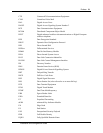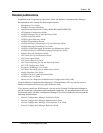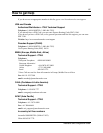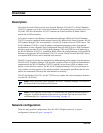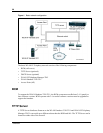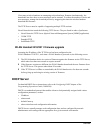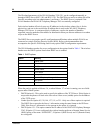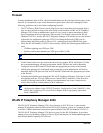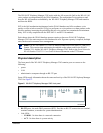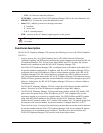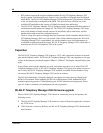
29
Overview
Overview
Description
The Nortel Networks Wireless Local Area Network Handsets 2210 and 2211 (WLAN Handsets
2210/2211) operate over an 802.11b wireless Ethernet LAN providing users a wireless Voice over
IP (VoIP). The WLAN Handsets 2210/2211 emulate the Nortel Networks IP Phone 2004 to
provide the VoIP functionality.
To be able to connect to the Business Communications Manager (BCM), the WLAN Handsets
2210/2211 must be supplied with the Internet Protocol (IP) address of the Nortel Networks WLAN
IP Telephony Manager 2245 and, optionally, a Trivial File Transfer Protocol (TFTP) Server. The
WLAN Handsets 2210/2211 accept IP address configuration parameters either from manual
configuration or from a Dynamic Host Configuration Protocol (DHCP) Server. DHCP automatic
discovery mode provides WLAN IP Telephony Manager 2245 and TFTP Server IP addresses to
the WLAN Handsets 2210/2211. In addition, DHCP allows the Unified Manager (UM) and BCM
Monitor to recognize the WLAN Handsets 2210/2211 as such. The BCM can be the DHCP Server,
or a separate DHCP Server can be installed in the network.
The 802.11b protocol provides no mechanism for differentiating audio packets from data packets.
The WLAN IP Telephony Manager 2245 provides a Quality of Service (QOS) mechanism that is
implemented in the WLAN Handsets 2210/2211 and the Access Points (APs) to enhance voice
quality over the wireless network. The WLAN IP Telephony Manager 2245 gives preference to
voice packets over data packets on the wireless medium, increasing the probability that all voice
packets are transmitted efficiently and with minimum or no delay.
The WLAN Handsets 2210/2211 use the TFTP Server to update the wireless telephone firmware
over the 802.11b WLAN.
Network configuration
There are many possible configurations for a WLAN IP Telephony network. A typical
configuration is shown in Figure 1 on page 30.
Note: In this document, Nortel Networks WLAN IP Telephony Manager 2245 refers to
the SpectraLink Voice Priority (SVP) Server.
Note: For the purposes of this book, it is assumed that site planning and deployment is
complete. A general description of the process is provided. This can assist you when
troubleshooting. See “Appendix D: Provisioning” on page 113.



